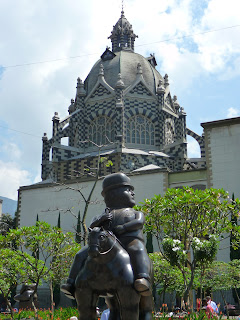Después de un viaje de 9 horas en un autobús de la noche, llegué a Medellín el 11 enero muy temprano en la mañana. Aquí me quedo en un hostel que está al lado del centro en un barrio muy relajado. Afortunadamente, podía dormir bastante en el autobús entonces no había ningún problema con empezar descubriendo la ciudad.
Durante muchos años, Medellín tenía una reputación muy mala para ser centro del cartel de Pablo Escobar (EDM). Con el autobús, pasamos cerca de la Hacienda Nápoles que estaba el centro de su actividad y donde reunió más de 200 especies de animales exóticos para la región, como hipopótamos, jirafas, elefantes, cebras y avestruces. Un pasajero me contó historias de esta época cuando hicimos una parada en la valle entre las dos Cordilleras.
Escobar no era jugador del campo pequeño: según Forbes, acumuló una fortuna superior a los tres mil millones de dólares y así estaba el séptimo hombre más rico en el mundo. En los años '70, entró en la política, construyó muchas obras benéficas para los pobres e impuso la ley de "plata o plomo", por la cual muchos miembros del gobierno, policía y militares colombianos o aceptaban la "plata" o les caía una lluvia de "plomo". En su mejor momento logró acumular una influencia mayor en múltiples círculos legales, civiles, económicos, religiosos y sociales de Medellín, de Antioquia (la región de Medellín) y del país.
Pero todo se termina un día, un artículo reveló su campo de actividad en 1983. Escobar se fue a ilegalidad y así empezó la violencia de que Colombia sufrió durante demasiados años. Finalmente, después de un año y cuatro meses de intensas labores de inteligencia, el "Bloque de Búsqueda" (un cuerpo conformado por la Policía Nacional, el ejército y el DEA de los EEUU) lo mató en 1993. Aún así, Medellín necesitaba bastante tiempo para regresar al paz.
Hoy es afortunadamente muy diferente y la ciudad es muy bonita. Hay un sistema de metro nuevo que funciona super bien, incluido teleféricos para los barrios más pobres en las partes montañosas que se llama MetroCable (las estaciones de que son realmente parecidos a un campo de esquí). Como en Bogotá, aquí también hay muchos museos interesantes (también con entrada gratuita). Y como Botero es de Medellín, claro que hay muchísimas de sus estatuas. Pongo aquí unas fotos que hice ayer durante mi paseo:
 |
| Plaza Bolívar |
 |
| Barrio Santo Domingo |
 |
| Plaza Botero |
 |
| Biblioteca España - vista del MetroCable |
 |
| MetroCable |
 |
| Plaza Botero |
 |
| Botero: Hombre en caballo |
En los próximos días, me voy a Cartagena y después a Leticia para ver la selva amazónica.
-------------------------------------------------------------------------------------------------------------
After a 9-hour night bus ride, I arrived to Medellín on 11 January very early in the morning. I'm staying in a hostel close to the center in a relaxed neighbourhood. Fortunately, I could sleep on the bus so nothing prevented me from exploring the city right away.
Medellín had a bad reputation for a long time for being the center of Pablo Escobar's cartel EDM. With the night bus, we passed close to the Hacienda Nápoles which was the headquarters of Escobar and where he assembled more than 200 species of exotic animals like hippos, giraffes, elephants, zebras and ostriches. One of the passangers told me stories about his time when we made a stop in the valley between the two Cordilleras.
Escobar wasn't a man of small stakes: according to Forbes, he accumulated a fortune of more than three billion dollars and at a certain point of time, he was considered being the seventh richest man on Earth. In the '70s, he started to enter the political scene, he financed major projects for the poor and also introduced the "silver or lead" policy - government, police and army members could make their choice whether to accept "silver", otherwise, "lead" might have taken over. In his best days, he had a major influence in different legal, civic, economical, religious and social circles in Medellín, in Antioquia (Medellín's region) and the entire country.
But all things come to an end, and in 1983, an article revealed his real means. Escobar went to illegality and the "cocaine war" viloence started from which Colombia suffered for too many years. In the end, after almost a year and a half of manhunt, the "Search Block" made of the National Police, the army and the US's DEA, he was gunned down in 1993. Still, Medellín needed more time to return to peace.
Today, luckily it's very different and the city is really nice. There's a new metro line which works very well, there're even cable cars included in the system (called MetroCable) which connect the less privileged neighbourhoods in the mountain areas with the city. Its stations really look like any ski lift in an Austrian resort. Like in Bogotá, there are many interesting museums, most of them with free entrance. And since Botero is from Medellín, of course there are loads of sculptures made by him.
In the coming days, I'll first go to Cartagena and then to Leticia to see the Amazonian rainforest.
No comments:
Post a Comment